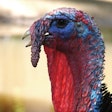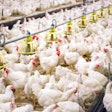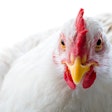
Following the mass mortality of water birds at a natural park in Shaanxi, tests in China revealed the detection of the H5N8 HPAI virus variant for the first time in the province.
According to the official report from the Chinese authorities to the World Organisation for Animal Health (OIE), more than 4,200 grebes died at the Hongjiannao national nature reserve at the end of May.
Diving water birds, this flock of grebes was located near to Erlintu. This town is located in the Yulin city region in the north of Shaanxi province, which is part of Northwestern China.
After the infection was confirmed, the authorities initiated emergency procedures, according to China’s agriculture ministry. This included removing the dead birds, and disinfecting the surrounding area.
The latest HPAI outbreak is the seventh in China so far this year, reports the ministry. All cases have been detected in wild birds. Last month, the same virus variant was detected for the first time in the Tibet autonomous region, also in wild birds.
Farm outbreak reported in Iraq
Presence of a similar H5N8 HPAI virus variant was confirmed earlier this month in another poultry flock in Iraq. Of the around 60,000 poultry at the farm in Safwan, 45,000 died and the rest have been destroyed, according to the OIE report.
Located in the Basrah governorate in the southeast of Iraq, the affected farm was near to the border with Kuwait.
Since the start of 2021, there have now been three HPAI outbreaks linked to this virus subtype in Iraq. Earlier outbreaks were in the central governorate of Saladin. In total, more than 260,000 poultry have been directly involved in these outbreaks through mortality or culling.
Taiwan slaughterhouse detects HPAI cases in native chickens
Between early March and mid-May, postmortem investigations at a poultry slaughterhouse in Taipei have identified three cases that tested positive for the H5N2 HPAI virus variant. According to the OIE report, each of these was among a small group of between seven and 11 native chickens. All 28 of the carcasses have been destroyed at the facility in Wanhua district.
After a four-month hiatus last year, this virus variant was detected again among Taiwan’s poultry population in August of 2020. Since then, five outbreaks have now been officially recorded. More than 800 birds have died, and over 14,000 have been culled to halt the further spread of infection.
Avian flu restrictions eased in Japan
Since the H5N8 HPAI virus returned to the country in early November of last year, 65 outbreaks have been confirmed to the OIE by the Japanese veterinary authority. The number of poultry directly impacted now stands at more than 9.972 million.
According to the latest update from Japan, a further 164 poultry have been culled. These included three laying hens at a farm in Miyazaki prefecture hit by the disease in January, and 161 layers at another facility in Ibaraki, where HPAI was confirmed in early February. Restrictions at these facilities were lifted on March 3 and March 10, respectively.
Japan’s most recent outbreak was confirmed on March 13. Affected was a flock of 77,000 laying hens in the town of Hago in Tochigi prefecture. Following depopulation and disinfection, restrictions on this farm were eased on April 10, according to the latest OIE report.
Egg imports raised further in South Korea
At the start of this month, the agriculture ministry announced it would allow imports of 50 million eggs during June. This was 10 million more than in each of the two preceding months.
However, in order to stabilize supplies and prices following a series of earlier HPAI outbreaks, Yonhap news agency reports that the figure has now been raised to 70 million for the month. This was announced by the country’s finance minister last week.
High egg prices are among the factors blamed for high food price inflation in the country last month.
So far this year, South Korea has increased its imports by more than 100 million eggs to ease the continuing egg shortage. Although no new HPAI cases have been detected in the country’s poultry flocks for more than two months, laying hen numbers are yet to recover fully from the earlier outbreaks.
Since HPAI hit South Korea in November of 2020, 109 outbreaks of the disease have been confirmed. These directly involved almost 10.26 million poultry — 22,000 mortalities and 10.24 million culls.
New human case of influenza A(H5N6) in China
Earlier this month, China’s National Health Commission reported one new case of human infection with avian influenza A(H5N6) virus to the World Health Organization (WHO).
The patient was a 49-year-old woman from Chengdu in Sichuan province. Her symptoms began on May 13, and she was admitted to hospital on May 16 with severe pneumonia. Her present condition is not reported.
Although this virus is associated with poultry, this patient had no clear history of contact with birds. There are no further cases among her close contacts.
Since 2014, 32 laboratory-confirmed cases of human infection with influenza A(H5N6) virus have been reported to the WHO in the Western Pacific Region. Of these, 19 patients have died.
Recently, Chinese authorities confirmed the world’s first human case of influenza caused by an H10N3 virus that had originated in birds.
View our continuing coverage of the global avian influenza situation.















